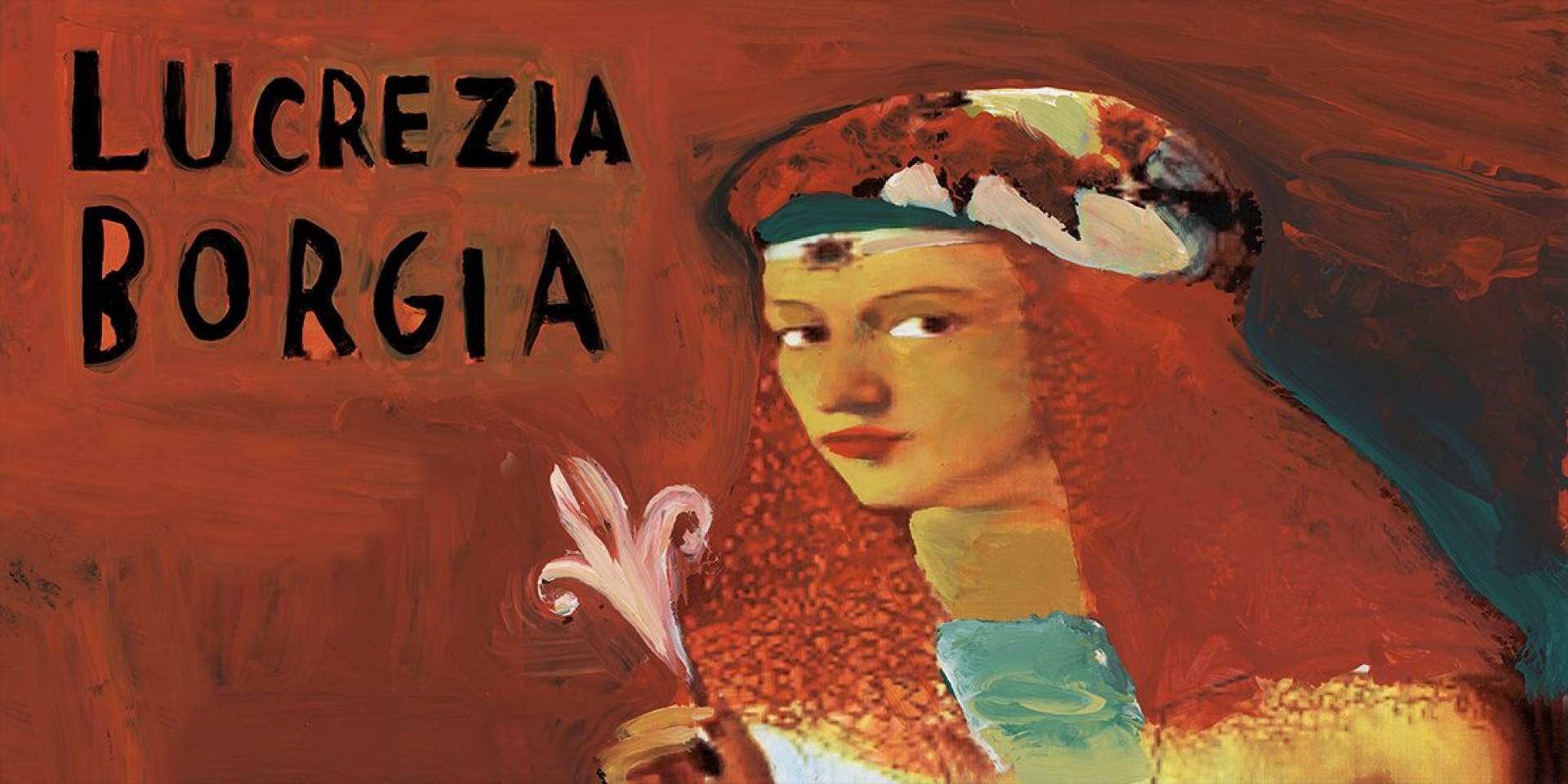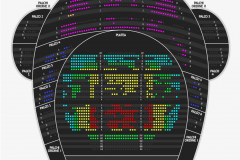Lucrezia Borgia
Mo | Tu | We | Th | Fr | Sa | Su |
Composed in the autumn of 1833, Lucrezia Borgia debuted at the Teatro alla Scala on 26 December of the same year. The source is the homonymous drama by Victor Hugo that Felice Romani, author of the libretto, arranged in a prologue and two acts. It was Donizetti himself who suggested to Romani that he make an opera libretto from Hugo's drama, attracted as much by the high-tension situations present in the text as by the dark atmospheres that surround the story.
Lucrezia Borgia, a woman ruthless in the management of power and ready to eliminate all her enemies, finds her secret son Gennaro in Venice, whom she had to abandon at a young age. The young man, unaware of the truth, feels attracted to that masked noblewoman, until her friends reveal her identity by tearing off her mask and publicly insulting her. From that moment on, a series of increasingly dramatic events is triggered that will lead to the poisoning of Gennaro's group of friends, including himself. Only at the end of the opera, during a pathos-filled duet, will the young man discover that he is the son of the much-hated Lucrezia.
In Lucrezia Borgia, Donizetti musically forged the figure of a very complex woman with a dual personality. The role of the protagonist, as ruthless with her enemies as she is loving with her secret son, requires an interpreter with vocal mastery combined with a great dramatic personality.
New staging
Synopsis
Time: Early 16th century
Place: Venice and Ferrara
Prologue
Scene 1
The Palazzo Grimani in Venice
Gennaro and his friends, including Orsini, celebrate on the brightly lit terrace, in front of which lies the Giudecca Canal ("Bella Venezia!"). The friends' conversation turns to Don Alfonso, Duke of Ferrara, to whose house they will be travelling the next day, and to his wife, the infamous Lucrezia Borgia. On hearing Lucrezia's name, Orsini tells of how Gennaro and he, alone in a forest, were warned by a mysterious old man to beware her and the entire Borgia family, and that the two of them would die together ("Nella fatal di Rimini"). Professing his boredom with Orsini's tale Gennaro wanders off and falls asleep nearby. His friends are invited to rejoin the festivities, and he is left behind ("Senti! La danza invitaci").
Scenes 2 and 3
A gondola appears, and from it a masked woman exits onto the terrace ("Tranquillo ei posa..."). She observes the sleeping Gennaro with affection and hurries over to him ("Com'è bello! Quale incanto in quel volto onesto e altero!"). When she kisses Gennaro's hand, he wakes and is instantly struck by her beauty ("Leggiadra e amabil siete"). He expresses his love for her, but admits that the one person nearer to him is his mother that he has never met. He sings of his childhood as an orphan brought up by a common fisherman father ("Di pescatore ignobile esser figliuol credei"). The woman, sympathetic to his plight, weeps for him ("Ama tua madre, e tenero sempre per lei ti serba...").
The others return ("Gente appressa... io ti lascio") and seem to recognise her, listing in turn the members of their families she has killed, to Gennaro's horror and disbelief ("Maffio Orsini, signora, son'io"). Gennaro is then finally told that the woman is Lucrezia Borgia.
Act 1
Ferrara
The Duke, believing Gennaro to be Lucrezia's lover, plots his murder with his servant Rustighello ("Vieni: la mia vendetta è meditata e pronta"). Gennaro and his companions leave the house for a party and pass the Duke's palace with its large gilded coat of arms reading Borgia. Keen to show his contempt for the Borgia family, Gennaro removes the initial "B", leaving the obscene "Orgia" (orgy).
In the palace, Lucrezia is shown into the Duke's chamber. Having seen the defaced crest, she demands death for the perpetrator, not knowing that it is Gennaro. The Duke orders Gennaro to be brought before her and accuses him of staining the noble name of Borgia, a crime to which he readily confesses. Lucrezia, horrified, attempts to excuse the insult as a youthful prank, but Don Alfonso accuses Lucrezia of infidelity, having observed her meeting with Gennaro in Venice. In a scene full of drama and tension, she denies any impropriety, but he demands the prisoner's death and forces her to choose the manner of Gennaro's execution. Pretending to pardon him, the Duke offers Gennaro a glass of wine and he swallows it. After a stunning trio ("Guai se ti sfugge un moto, se ti tradisce un detto!") the Duke leaves and Lucrezia hurries to Gennaro, giving him an antidote to the poison the Duke has mixed with the wine. He drinks, and in a last duet, she implores him to flee the city and her husband ("Bevi e fuggi... te'n prego, o Gennaro!").
Act 2
The palace of the Princess Negroni
Ignoring Lucrezia's advice, Gennaro attends a party at the palace, swearing never to be parted from his friend Orsini. Orsini leads the party in a brindisi or drinking song ("Il segreto per esser felici") and they drink. Lucrezia enters and announces that in revenge for their insults in Venice she has poisoned their wine and arranged five coffins for their bodies. She has hitherto believed that Gennaro fled Ferrara on her advice, and is thus dismayed when he steps forward and announces that she has poisoned a sixth. Orsini, Liverotto, Vitellozzo, Petrucci and Gazella fall dead. Gennaro seizes a dagger and attempts to kill Lucrezia, but she stops him by revealing that he is in fact her son. Once again she asks him to drink the antidote, but this time he refuses, choosing to die with his friends. In a final cabaletta ("Era desso il figlio mio"), Lucrezia mourns her son and expires.
Program and cast
RUNNING TIME
Approximately 2 hours and 50 minutes (intermission included)
ARTISTS
Conductor: Francesco Ivan Ciampa
Director: Andrea Bernard
Sets: Andrea Beltrame
Costumes: Elena Beccaro
Lights: Marco Alba
Maggio Musicale Fiorentino Orchestra and Chorus
Chorus master: Lorenzo Fratini
Alfonso I d'Este: Mirko Palazzi
Lucrezia Borgia: Jessica Pratt
Gennaro: René Barbera
Maffio Orsini: Laura Verrecchia
Teatro del Maggio Florence State Opera Italy
Teatro del Maggio is in the centre, close to the old city walls, next to the historic Stazione Leopolda. The garden that welcomes visitors is Piazzale Vittorio Gui, named after the founder of the Stabile Orchestrale Fiorentina and the Maggio Musicale Fiorentino.
By train
Santa Maria Novella is Florence's main train station.
From there you can reach the theatre with a short walk (about 10-15 minutes) or by taking the tram (a stop) or a taxi.
By car
The Opera di Firenze is just outside the ZTL area.
It is possible to park near the Parco delle Cascine or for a fee in the Porta al Prato car park (Via Elio Gabbuggiani, 7) and in the Piazza Vittorio Veneto car park.
By bus
Lines C1, C2 and D (Leopolda stop);
Lines 17 and 23A-B (stop Via delle Carra);
Lines 17B-C, 22, 23N, 23 and 57 (Pierluigi da Palestrina stop);
Lines 29, 29B, 29BA, 29BC, 29D, 30A, 30B, 30AC, 35 and 35° (stop Leopolda - Porta al Prato; Capolinea).
By tram
Line T1 (stop Porta al Prato - Parco della musica).

 EN
EN DE
DE IT
IT FR
FR ES
ES RU
RU JP
JP RO
RO
 Seating plan
Seating plan 